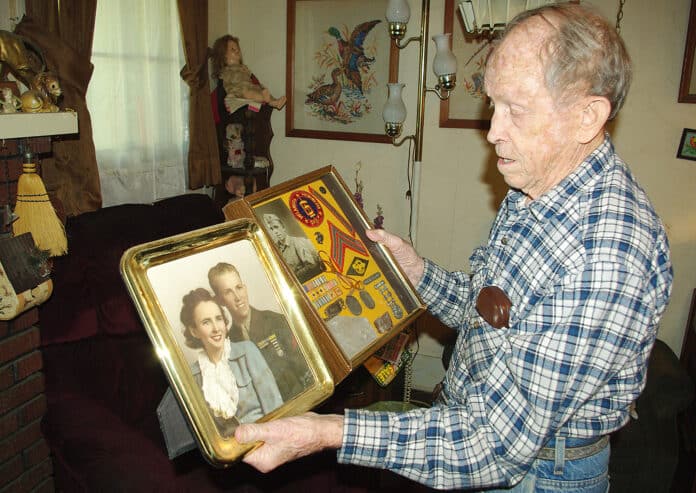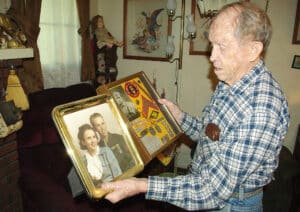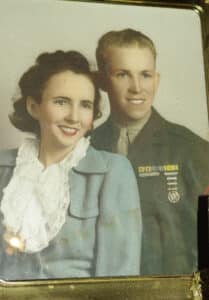
Editor’s Note. This article appeared in The Carthage Press in November 2010. This year, the movie “Midway,” about the pivotal naval battle, June 4-6, 1942, was released over Veterans Day Weekend. Carthage resident Leslie Strait was a U.S. Marine stationed on Midway Atoll from October 1941, before the attack on Pearl Harbor, until after the battle. Strait died on July 22, 2013, but on this Veterans Day, we remember his service and how he witnessed and participated in this vital action in American history. A link to his obituary can be found here. https://www.findagrave.com/memorial/114326233/leslie-raymond-strait
On June 4, 1942, the mightiest concentration of naval power ever gathered by the Japanese in the Pacific Ocean was poised to attack American troops on a tiny speck of land called Midway Island, located more than 1,300 miles west of Honolulu, Hawaii.
Carthage resident Leslie Strait, who joined the U.S. Marine Corps in July 1941, had been stationed on Midway since October 1941 when it was a lonely outpost garrisoned by fewer than 300 Marines and a handful of cast-off U.S. Navy fighter planes.
By the beginning of June 1942, that same outpost was home to thousands of soldiers, sailors and airmen as the American forces in the Pacific scraped together everything they could to defend Midway and its airfield, only about 1,300 miles from the U.S. Pacific Fleet’s main base at Pearl Harbor in Hawaii.
Before the war
Strait was born and grew up in Mount Vernon, graduating from high school there before joining his parents who had moved to Carthage some time before.
“I stayed in Mount Vernon until I graduated. My folks moved here about three months before that. My folks lived in Carthage and then they left Carthage and moved down to Crane, Missouri,” Strait said. “Dad was with the railroad and I stayed here in Carthage.”
Strait said he joined the Marines on June 20, 1941 in St. Louis and spent the next three months in boot camp.
“They got us trained out of boot camp, and they didn’t have any place for us to go, so they sent 60 of us out to Pearl Harbor and they sent us from Midway from there,” Strait said. “They sent some of us to Johnston Island, some of to Wake, and they sent 15 of us to Midway Island. My last name started with an S, I was with the last group and 15 of us went to Midway.”
Strait said he arrived on the tiny atoll in October 1941. Midway is three tiny islands and a lagoon surrounded by a coral reef. Sand Island is the largest of the islands at 1,200 acres, followed by Eastern Island at 334 acres and tiny Spit Island at 15 acres.
It is located about one third of the way between Honolulu and Tokyo. It is about 3,200 miles west of San Francisco, 2,500 miles east of Tokyo and 161 miles east of the International Date Line.
“I arrived on Midway the 29th of October and on December 7 the war started,” Strait said. “I didn’t think a lot about that island but the men there were preparing for war already. They were building gun positions and sandbag parapets and stuff like that.”
War comes
On Dec. 7, 1941, the Japanese launched a coordinated series of strikes across the Pacific. The attack on Pearl Harbor was the major element in that series of attacks. Another was a strike on Midway that same day by two Japanese destroyers that raked the islands with artillery fire, killing four men, injuring 10 and destroying a patrol plane.
“I was stationed on the powerhouse about 60 feet above the ground,” Strait said. “It was a bombproof building. It was made to be bombproof because it had a 10-foot space between the roof and the top over the powerhouse and we were down in there. They zeroed in on us at the powerhouse and hit the side of it and around it and we were in a gun position on top of it. It was frightening.”
The men on Midway listened to the radio and on a cable that ran west from Midway as the American defenders on another tiny atoll, Wake Island, about 1,200 miles west of Midway, fought off one Japanese invasion.
“We listened to the radio when Wake Island was attacked and the boys there fought them off for 21 days,” Strait said. “A handful of men, 240 men, fought off the Japanese invasion.”
Wake fell two days before Christmas when a second Japanese invasion force overwhelmed the defenders.
Strait and his fellow soldiers feared they were next, but nothing happened other than an occasional artillery attacks from a Japanese submarine that surfaced off shore to fire its deck gun at the Marines.
“We got shelled five times,” Strait said. “Sometimes submarines would come out and shell us. Midway was the furthest west place we had after Wake fell.”
Buildup to battle
Then in April 1942, a series of events started that would lead to the titanic battle that would turn the tide of war.
First, U.S. Army Airmen, commanded by Col. Jimmy Doolittle, took off in 16 twin-engine bombers from the aircraft carrier USS Hornet and bombed the Japanese homeland.
Long-time Joplin resident Travis Hoover took part in that attack, piloting the second B-25 Mitchell bomber off the Hornet.
The Japanese figured out that the planes had to come from American carriers and worked on a plan to draw the U.S. Pacific Fleet out to a final battle.
As planners worked in Tokyo, two aircraft carrier task forces, one Japanese and one American, met in combat in the Coral Sea in May, hundreds of miles south of Midway. It was the first naval battle where opposing ships never sighted each other. It was entirely fought by carrier bombers, fighters and torpedo planes.
The U.S. Navy forced the Japanese to retire, but lost one of the Pacific fleet’s four big aircraft carriers, the USS Lexington, in the battle. The other U.S. carrier, the USS Yorktown, was damaged, but thanks to heroic work by shipyard workers at Pearl Harbor, it was put back into service in time for the coming battle near Strait’s station. Neither of the Japanese carriers that participated in the Battle of the Coral Sea were available for Midway.
“We knew about the Battle of the Coral Sea,” Strait said. “They told us they were coming. Our patrol planes would go out and search for the Japanese and pass the planes at Wake.”
In the meantime, at U.S. Pacific Fleet headquarters at Pearl Harbor, American intelligence officers had broken the Japanese radio code and figured out that the Japanese were planning to invade Midway with a massive fleet of more than 200 ships, the largest fleet ever to put to sea.
To counter this thrust, the American commander, Admiral Chester Nimitz, threw everything he had, 26 ships, including three aircraft carriers. He also moved as many planes as he could spare and all the troops he could muster, to Midway.
“They had a whole line of ships bringing us stuff,” Strait said. “They were all loaded with troops and guns and everything. They sent a lot of guys out to get them war conditioned and they would just send them out on the island. We had barracks but we were living at our gun positions by then. We had underground parapets. We had four machine guns protecting the powerhouse and we had three-inch anti aircraft guns around it too.”
Strait and his fellow soldiers knew something big was up and prepared to defend their island home.
“They sent out a bunch of planes,” Strait said. “They had over a hundred planes on the island, some times they had to fly around the island it was so crowded.”
Battle begins
On June 3, 1942, Strait and his fellow soldiers found out that Japanese ships and planes had bombed a city in Alaska. At the same time, patrol planes from Midway spotted the Japanese invasion fleet headed for Midway and long-range Army bombers struck the ships, causing no damage.
The next day, planes from four Japanese aircraft carriers hit Midway with the heaviest attack it had taken since the war began.
“That was June 4, I had been transferred on the breakwater,” Strait said. “There were four three-inch guns down close to the dock and the road came right down to the dock from the whole island and the Japanese planes came down along the road strafing. Then they would get to the end of the island and they pulled up and disappeared, they were so danged fast.”
Strait said the crews on the island got their bombers, fighters and torpedo planes off the tiny airfield at Midway. The fighters rose to challenge the Japanese planes while the bombers and torpedo planes flew off to attack the Japanese carriers.
The American fighters were slaughtered by their more experienced and faster Japanese opponents and the Japanese planes struck the island’s defenses.
Strait recalled watching a particularly odd fight between U.S. Navy PT boats and Japanese planes in Midway’s lagoon during the attack.
“We had 11 PT boats out there in the lagoon,” Strait said. “They went out and cruised around and when the Japanese attacked, a plane came down between two PT boats and they shot him down. I saw the airplane and I’ve got a piece of that airplane, made of balsa wood. They drug it out of the bay and put it on the dock. There were Japanese bodies in it too.”
Strait still has that piece of the airplane, preserved in a glass case with his medals and other awards he earned during World War II.
Out at sea, the Japanese carrier force fought off Midway’s bombers with no damage to any of their ships. Japanese scout planes found one of the American carriers, the Yorktown and the Japanese fleet turned northeast to attack.
But American carrier planes were already in the air. In a series of disjointed attacks, American torpedo bombers, slow and vulnerable in the way they had to attack ships down low and close to the water, were slaughtered. One squadron, Torpedo 8, from the USS Hornet, lost all 15 planes and had 29 of the 30 airmen killed in the action.
But the torpedo planes pulled the Japanese fighter on patrol over their carriers down to low altitude, leaving them unable to respond when U.S. dive bombers appeared at higher altitude.
In a matter of minutes, about 45 U.S. dive bombers had hit three of the four Japanese carriers, causing fires and explosions on the ships, which were refueling and rearming aircraft on their decks and in their hanger decks.
Those three carriers were out of action, but the fourth carrier launched two attacks on the Yorktown, crippling her. The two surviving American carriers launched another attack that hit the fourth Japanese carrier and set her on fire as well.
The outnumbered U.S. Navy won the Battle of Midway, sinking four Japanese aircraft carriers while losing only one, the previously damaged Yorktown.
After the battle
Strait spent several more months on Midway Island before returning home for several months of leave.
While he was home, he married his sweetheart, Eunice Emma (Hill) Strait, on Oct. 9, 1943 before he was sent back to the Pacific.
He served on several islands and moved around the Pacific as the war moved westward toward Japan. At one point, he was stuck on a ship for 70 days as it sailed between islands.
“I went to Guam and I was on a ship for 70 days going to Guam,” Strait said. “We came up from Guadalcanal. We had been sent to Guadalcanal to learn how to set up a camp if we had to set one up. I went over to Tulagi Island. Then we went onboard a ship and we were on a ship for 70 days, that’s more than two months. It was calm water there though, I’ve seen water so calm it was like a piece of glass.”
Strait said he didn’t see combat after Midway.
“I was just damned lucky because I was a machine gunner,” Strait said. “They used a lot of machine gunners on landings, but I didn’t get called up.”



After the war ended, Strait returned home to Carthage and went to work for his father-in-law.
“I went to work in a plumbing shop here in Carthage,” Strait said. “My father-in-law owned it. He said you’ve got a job any time you need it and I said I’ll take it. I got out of the Marines the 20th of December and got back to Chicago and I went to work for him the first day of January. I went to work in a plumbing shop and learned to be a plumber. It wasn’t but a few years later that that shop was dropped on me.”
He and his wife raised two children and he joined the Lions Club. In more than 50 years as a member of the Lions Club, he has yet to miss a meeting.
“Most of the guys back then belonged to a civic organization and it just happened to be the Lions Club was the first one that asked me,” Strait said.
His wife died a little more than a year ago, March 11, 2009. He now lives with his daughter and her husband at his home on Grand Avenue in Carthage.
Strait can be seen every Fourth of July near the Lions Club food booth at the Carthage Golf Course as people gather to watch the fireworks.
Of course the fireworks he sees here are nothing compared to the fireworks he saw on that June day on an island more than 5,000 miles from Carthage.
“I’ve got all these books here, about 10 or 11 and all of them have something about Midway in them,” Strait said. “Anybody who has a article about Midway, some people bring them to me and give them to me.
“I haven’t found myself in any of them yet. I see a lot of things I can relate to. I’ve seen what they were talking about.”














